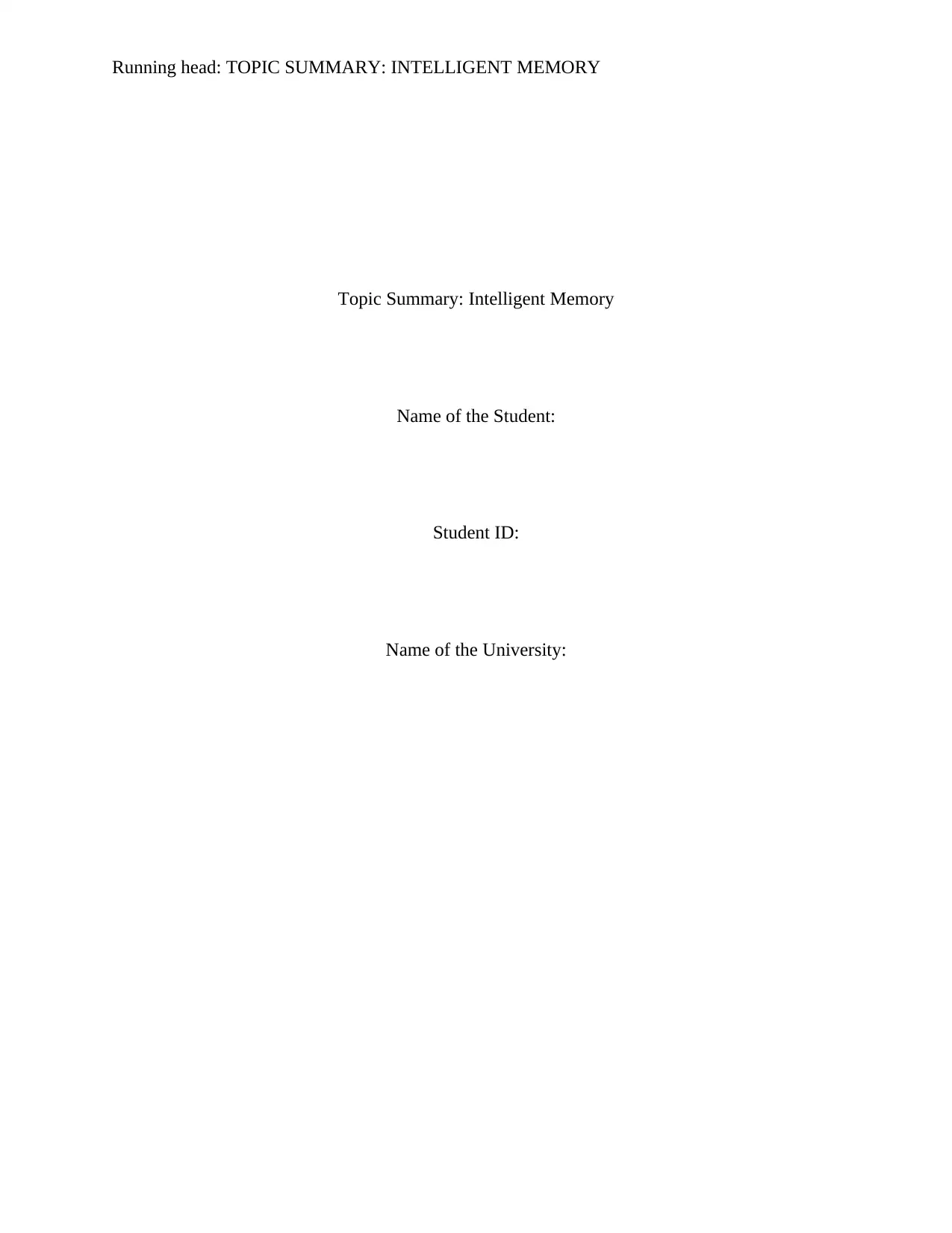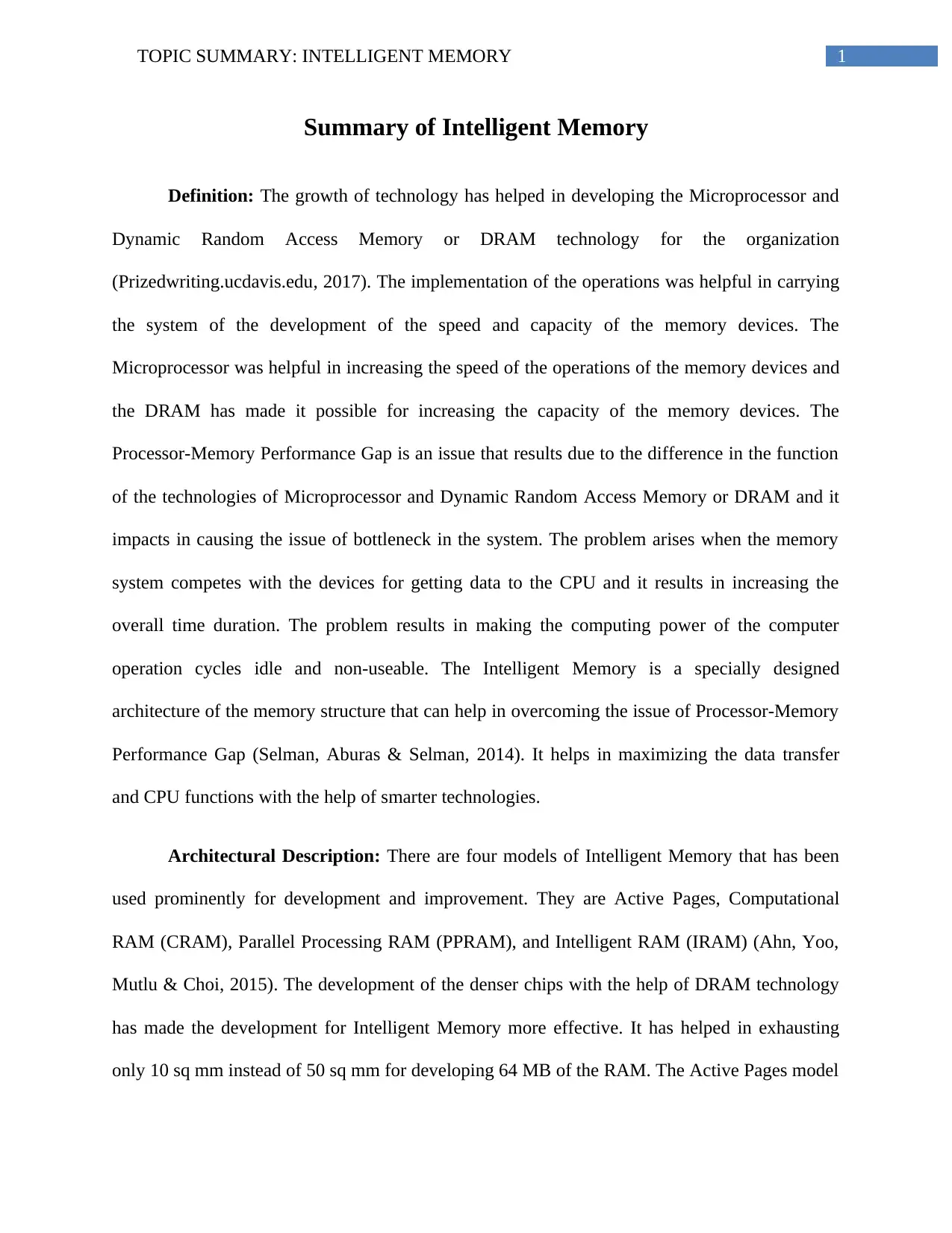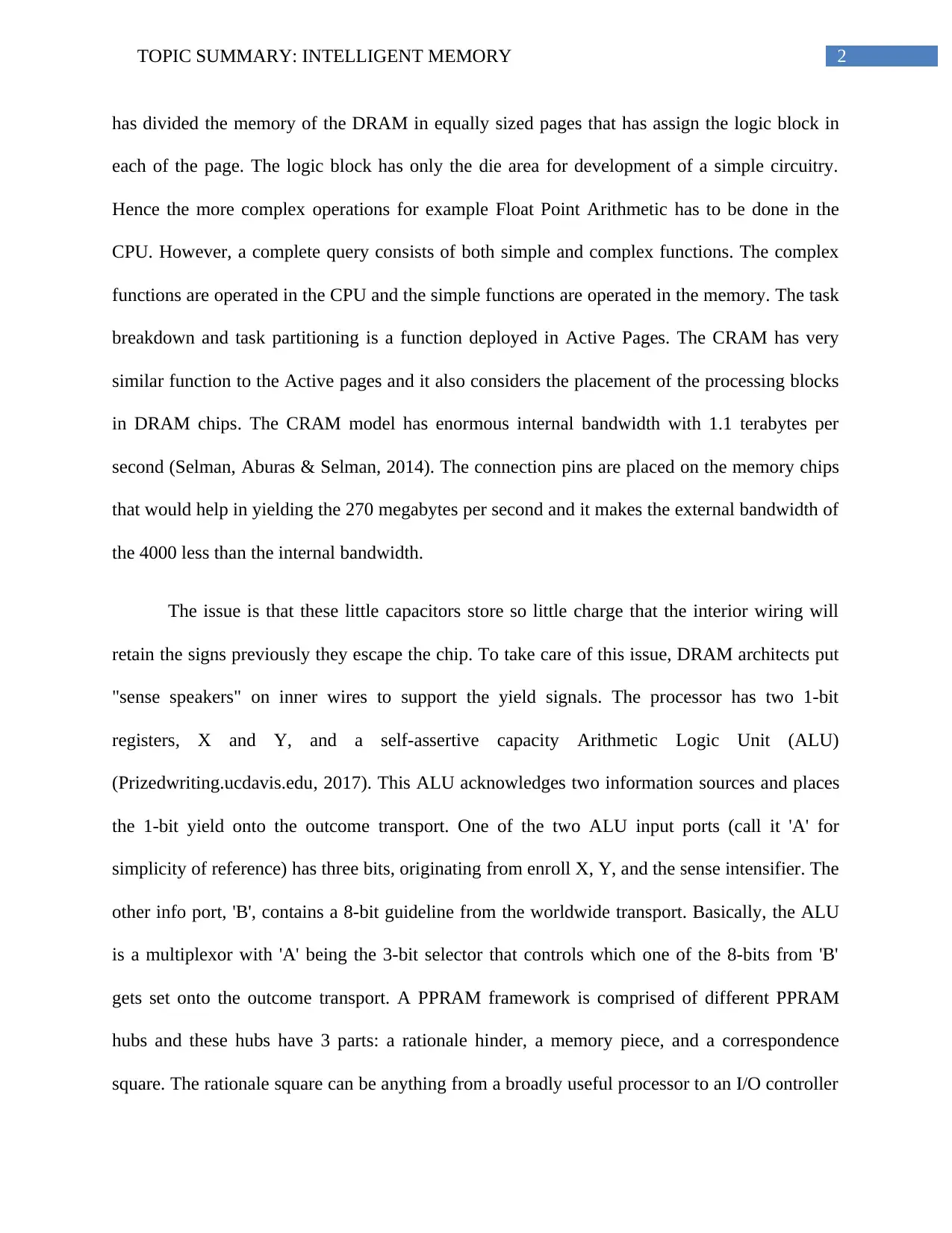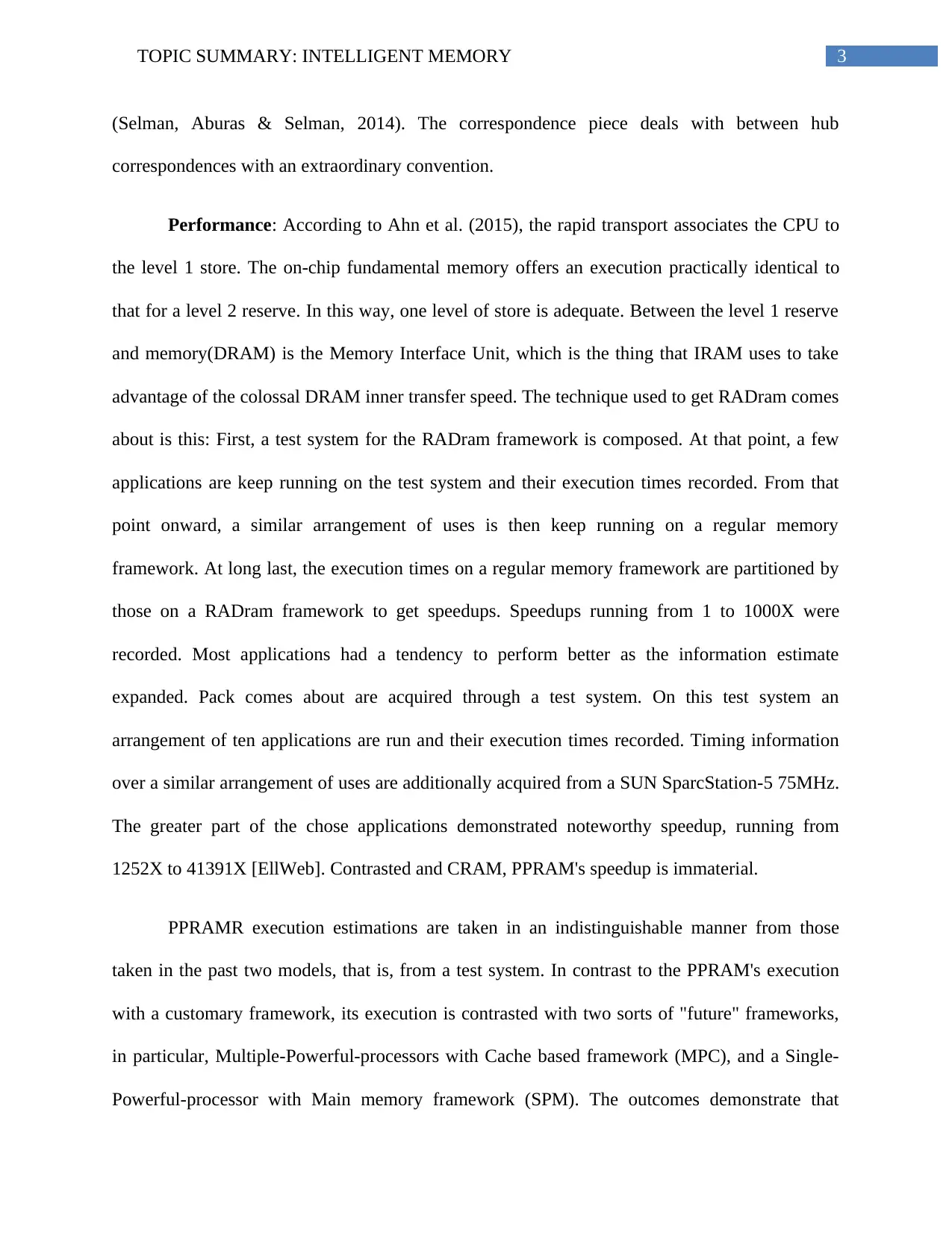Intelligent Memory: Overcoming Processor-Memory Performance Gap
VerifiedAdded on 2023/06/15
|6
|1375
|274
AI Summary
This article discusses Intelligent Memory, a specially designed architecture of the memory structure that can help in overcoming the issue of Processor-Memory Performance Gap. It covers its definition, architectural description, and performance. The article also discusses the four models of Intelligent Memory that have been used prominently for development and improvement.
Contribute Materials
Your contribution can guide someone’s learning journey. Share your
documents today.

Running head: TOPIC SUMMARY: INTELLIGENT MEMORY
Topic Summary: Intelligent Memory
Name of the Student:
Student ID:
Name of the University:
Topic Summary: Intelligent Memory
Name of the Student:
Student ID:
Name of the University:
Secure Best Marks with AI Grader
Need help grading? Try our AI Grader for instant feedback on your assignments.

1TOPIC SUMMARY: INTELLIGENT MEMORY
Summary of Intelligent Memory
Definition: The growth of technology has helped in developing the Microprocessor and
Dynamic Random Access Memory or DRAM technology for the organization
(Prizedwriting.ucdavis.edu, 2017). The implementation of the operations was helpful in carrying
the system of the development of the speed and capacity of the memory devices. The
Microprocessor was helpful in increasing the speed of the operations of the memory devices and
the DRAM has made it possible for increasing the capacity of the memory devices. The
Processor-Memory Performance Gap is an issue that results due to the difference in the function
of the technologies of Microprocessor and Dynamic Random Access Memory or DRAM and it
impacts in causing the issue of bottleneck in the system. The problem arises when the memory
system competes with the devices for getting data to the CPU and it results in increasing the
overall time duration. The problem results in making the computing power of the computer
operation cycles idle and non-useable. The Intelligent Memory is a specially designed
architecture of the memory structure that can help in overcoming the issue of Processor-Memory
Performance Gap (Selman, Aburas & Selman, 2014). It helps in maximizing the data transfer
and CPU functions with the help of smarter technologies.
Architectural Description: There are four models of Intelligent Memory that has been
used prominently for development and improvement. They are Active Pages, Computational
RAM (CRAM), Parallel Processing RAM (PPRAM), and Intelligent RAM (IRAM) (Ahn, Yoo,
Mutlu & Choi, 2015). The development of the denser chips with the help of DRAM technology
has made the development for Intelligent Memory more effective. It has helped in exhausting
only 10 sq mm instead of 50 sq mm for developing 64 MB of the RAM. The Active Pages model
Summary of Intelligent Memory
Definition: The growth of technology has helped in developing the Microprocessor and
Dynamic Random Access Memory or DRAM technology for the organization
(Prizedwriting.ucdavis.edu, 2017). The implementation of the operations was helpful in carrying
the system of the development of the speed and capacity of the memory devices. The
Microprocessor was helpful in increasing the speed of the operations of the memory devices and
the DRAM has made it possible for increasing the capacity of the memory devices. The
Processor-Memory Performance Gap is an issue that results due to the difference in the function
of the technologies of Microprocessor and Dynamic Random Access Memory or DRAM and it
impacts in causing the issue of bottleneck in the system. The problem arises when the memory
system competes with the devices for getting data to the CPU and it results in increasing the
overall time duration. The problem results in making the computing power of the computer
operation cycles idle and non-useable. The Intelligent Memory is a specially designed
architecture of the memory structure that can help in overcoming the issue of Processor-Memory
Performance Gap (Selman, Aburas & Selman, 2014). It helps in maximizing the data transfer
and CPU functions with the help of smarter technologies.
Architectural Description: There are four models of Intelligent Memory that has been
used prominently for development and improvement. They are Active Pages, Computational
RAM (CRAM), Parallel Processing RAM (PPRAM), and Intelligent RAM (IRAM) (Ahn, Yoo,
Mutlu & Choi, 2015). The development of the denser chips with the help of DRAM technology
has made the development for Intelligent Memory more effective. It has helped in exhausting
only 10 sq mm instead of 50 sq mm for developing 64 MB of the RAM. The Active Pages model

2TOPIC SUMMARY: INTELLIGENT MEMORY
has divided the memory of the DRAM in equally sized pages that has assign the logic block in
each of the page. The logic block has only the die area for development of a simple circuitry.
Hence the more complex operations for example Float Point Arithmetic has to be done in the
CPU. However, a complete query consists of both simple and complex functions. The complex
functions are operated in the CPU and the simple functions are operated in the memory. The task
breakdown and task partitioning is a function deployed in Active Pages. The CRAM has very
similar function to the Active pages and it also considers the placement of the processing blocks
in DRAM chips. The CRAM model has enormous internal bandwidth with 1.1 terabytes per
second (Selman, Aburas & Selman, 2014). The connection pins are placed on the memory chips
that would help in yielding the 270 megabytes per second and it makes the external bandwidth of
the 4000 less than the internal bandwidth.
The issue is that these little capacitors store so little charge that the interior wiring will
retain the signs previously they escape the chip. To take care of this issue, DRAM architects put
"sense speakers" on inner wires to support the yield signals. The processor has two 1-bit
registers, X and Y, and a self-assertive capacity Arithmetic Logic Unit (ALU)
(Prizedwriting.ucdavis.edu, 2017). This ALU acknowledges two information sources and places
the 1-bit yield onto the outcome transport. One of the two ALU input ports (call it 'A' for
simplicity of reference) has three bits, originating from enroll X, Y, and the sense intensifier. The
other info port, 'B', contains a 8-bit guideline from the worldwide transport. Basically, the ALU
is a multiplexor with 'A' being the 3-bit selector that controls which one of the 8-bits from 'B'
gets set onto the outcome transport. A PPRAM framework is comprised of different PPRAM
hubs and these hubs have 3 parts: a rationale hinder, a memory piece, and a correspondence
square. The rationale square can be anything from a broadly useful processor to an I/O controller
has divided the memory of the DRAM in equally sized pages that has assign the logic block in
each of the page. The logic block has only the die area for development of a simple circuitry.
Hence the more complex operations for example Float Point Arithmetic has to be done in the
CPU. However, a complete query consists of both simple and complex functions. The complex
functions are operated in the CPU and the simple functions are operated in the memory. The task
breakdown and task partitioning is a function deployed in Active Pages. The CRAM has very
similar function to the Active pages and it also considers the placement of the processing blocks
in DRAM chips. The CRAM model has enormous internal bandwidth with 1.1 terabytes per
second (Selman, Aburas & Selman, 2014). The connection pins are placed on the memory chips
that would help in yielding the 270 megabytes per second and it makes the external bandwidth of
the 4000 less than the internal bandwidth.
The issue is that these little capacitors store so little charge that the interior wiring will
retain the signs previously they escape the chip. To take care of this issue, DRAM architects put
"sense speakers" on inner wires to support the yield signals. The processor has two 1-bit
registers, X and Y, and a self-assertive capacity Arithmetic Logic Unit (ALU)
(Prizedwriting.ucdavis.edu, 2017). This ALU acknowledges two information sources and places
the 1-bit yield onto the outcome transport. One of the two ALU input ports (call it 'A' for
simplicity of reference) has three bits, originating from enroll X, Y, and the sense intensifier. The
other info port, 'B', contains a 8-bit guideline from the worldwide transport. Basically, the ALU
is a multiplexor with 'A' being the 3-bit selector that controls which one of the 8-bits from 'B'
gets set onto the outcome transport. A PPRAM framework is comprised of different PPRAM
hubs and these hubs have 3 parts: a rationale hinder, a memory piece, and a correspondence
square. The rationale square can be anything from a broadly useful processor to an I/O controller

3TOPIC SUMMARY: INTELLIGENT MEMORY
(Selman, Aburas & Selman, 2014). The correspondence piece deals with between hub
correspondences with an extraordinary convention.
Performance: According to Ahn et al. (2015), the rapid transport associates the CPU to
the level 1 store. The on-chip fundamental memory offers an execution practically identical to
that for a level 2 reserve. In this way, one level of store is adequate. Between the level 1 reserve
and memory(DRAM) is the Memory Interface Unit, which is the thing that IRAM uses to take
advantage of the colossal DRAM inner transfer speed. The technique used to get RADram comes
about is this: First, a test system for the RADram framework is composed. At that point, a few
applications are keep running on the test system and their execution times recorded. From that
point onward, a similar arrangement of uses is then keep running on a regular memory
framework. At long last, the execution times on a regular memory framework are partitioned by
those on a RADram framework to get speedups. Speedups running from 1 to 1000X were
recorded. Most applications had a tendency to perform better as the information estimate
expanded. Pack comes about are acquired through a test system. On this test system an
arrangement of ten applications are run and their execution times recorded. Timing information
over a similar arrangement of uses are additionally acquired from a SUN SparcStation-5 75MHz.
The greater part of the chose applications demonstrated noteworthy speedup, running from
1252X to 41391X [EllWeb]. Contrasted and CRAM, PPRAM's speedup is immaterial.
PPRAMR execution estimations are taken in an indistinguishable manner from those
taken in the past two models, that is, from a test system. In contrast to the PPRAM's execution
with a customary framework, its execution is contrasted with two sorts of "future" frameworks,
in particular, Multiple-Powerful-processors with Cache based framework (MPC), and a Single-
Powerful-processor with Main memory framework (SPM). The outcomes demonstrate that
(Selman, Aburas & Selman, 2014). The correspondence piece deals with between hub
correspondences with an extraordinary convention.
Performance: According to Ahn et al. (2015), the rapid transport associates the CPU to
the level 1 store. The on-chip fundamental memory offers an execution practically identical to
that for a level 2 reserve. In this way, one level of store is adequate. Between the level 1 reserve
and memory(DRAM) is the Memory Interface Unit, which is the thing that IRAM uses to take
advantage of the colossal DRAM inner transfer speed. The technique used to get RADram comes
about is this: First, a test system for the RADram framework is composed. At that point, a few
applications are keep running on the test system and their execution times recorded. From that
point onward, a similar arrangement of uses is then keep running on a regular memory
framework. At long last, the execution times on a regular memory framework are partitioned by
those on a RADram framework to get speedups. Speedups running from 1 to 1000X were
recorded. Most applications had a tendency to perform better as the information estimate
expanded. Pack comes about are acquired through a test system. On this test system an
arrangement of ten applications are run and their execution times recorded. Timing information
over a similar arrangement of uses are additionally acquired from a SUN SparcStation-5 75MHz.
The greater part of the chose applications demonstrated noteworthy speedup, running from
1252X to 41391X [EllWeb]. Contrasted and CRAM, PPRAM's speedup is immaterial.
PPRAMR execution estimations are taken in an indistinguishable manner from those
taken in the past two models, that is, from a test system. In contrast to the PPRAM's execution
with a customary framework, its execution is contrasted with two sorts of "future" frameworks,
in particular, Multiple-Powerful-processors with Cache based framework (MPC), and a Single-
Powerful-processor with Main memory framework (SPM). The outcomes demonstrate that
Secure Best Marks with AI Grader
Need help grading? Try our AI Grader for instant feedback on your assignments.

4TOPIC SUMMARY: INTELLIGENT MEMORY
PPRAMRhas a greatest speedup of 1.41X over MPC and 2.22X over SPM on five chose
applications (Ahn, Yoo, Mutlu & Choi, 2015). IRAM utilizes an alternate strategy to get
execution estimations. Not at all like the past three models where information are recorded from
test systems, IRAM predicts execution estimations from numerical equations. There are two
stages to this procedure: The first is to get application execution data, for instance clock cycles,
from a business processor. The second step is to utilize numerical recipes to decide how IRAM
would influence the execution data accumulated.
PPRAMRhas a greatest speedup of 1.41X over MPC and 2.22X over SPM on five chose
applications (Ahn, Yoo, Mutlu & Choi, 2015). IRAM utilizes an alternate strategy to get
execution estimations. Not at all like the past three models where information are recorded from
test systems, IRAM predicts execution estimations from numerical equations. There are two
stages to this procedure: The first is to get application execution data, for instance clock cycles,
from a business processor. The second step is to utilize numerical recipes to decide how IRAM
would influence the execution data accumulated.

5TOPIC SUMMARY: INTELLIGENT MEMORY
References
Ahn, J., Yoo, S., Mutlu, O., & Choi, K. (2015, June). PIM-enabled instructions: A low-overhead,
locality-aware processing-in-memory architecture. In Computer Architecture (ISCA),
2015 ACM/IEEE 42nd Annual International Symposium on (pp. 336-348). IEEE.
Prizedwriting.ucdavis.edu. (2017). Literature Review - Intelligent Memory | Prized
Writing.Retrieved 5 December 2017, from http://prizedwriting.ucdavis.edu/literature-
review-intelligent-memory
Selman, A. H., Aburas, A., & Selman, S. (2014). Intelligent memory allocation based on fuzzy
logic. Southeast Europe Journal of Soft Computing, 3(1)
References
Ahn, J., Yoo, S., Mutlu, O., & Choi, K. (2015, June). PIM-enabled instructions: A low-overhead,
locality-aware processing-in-memory architecture. In Computer Architecture (ISCA),
2015 ACM/IEEE 42nd Annual International Symposium on (pp. 336-348). IEEE.
Prizedwriting.ucdavis.edu. (2017). Literature Review - Intelligent Memory | Prized
Writing.Retrieved 5 December 2017, from http://prizedwriting.ucdavis.edu/literature-
review-intelligent-memory
Selman, A. H., Aburas, A., & Selman, S. (2014). Intelligent memory allocation based on fuzzy
logic. Southeast Europe Journal of Soft Computing, 3(1)
1 out of 6
Your All-in-One AI-Powered Toolkit for Academic Success.
+13062052269
info@desklib.com
Available 24*7 on WhatsApp / Email
![[object Object]](/_next/static/media/star-bottom.7253800d.svg)
Unlock your academic potential
© 2024 | Zucol Services PVT LTD | All rights reserved.